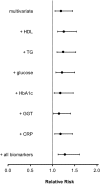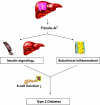Plasma fetuin-A levels and the risk of type 2 diabetes
- PMID: 18633113
- PMCID: PMC2551687
- DOI: 10.2337/db08-0538
Plasma fetuin-A levels and the risk of type 2 diabetes
Abstract
Objective: The liver-secreted protein fetuin-A induces insulin resistance in animals, and circulating fetuin-A is elevated in insulin resistance and fatty liver in humans. We investigated whether plasma fetuin-A levels predict the incidence of type 2 diabetes in a large prospective, population-based study.
Research design and methods: A case-cohort study within the European Prospective Investigation into Cancer and Nutrition (EPIC)-Potsdam study comprising 27,548 subjects was designed. We randomly selected a subcohort of 2,500 individuals of whom 2,164 were diabetes free at baseline and had anamnestic, anthropometrical, and metabolic data for analysis. Of the 849 incident diabetic case subjects identified in the full cohort during 7 years of follow-up, 703 remained for analyses after similar exclusions.
Results: Plasma fetuin-A levels were positively associated with diabetes risk after adjustment for age (relative risk [RR] for extreme quintiles 1.75 [95% CI 1.32-2.31]; RR for 10 mug/ml 1.04 [1.03-1.06]). The association remained significant after adjustment for sex, BMI, waist circumference, and lifestyle risk factors (RR for 10 mug/ml 1.03 [1.01-1.06]). Adjustment for glucose, triglycerides, HDL cholesterol, A1C, gamma-glutamyltransferase, or high-sensitivity C-reactive protein or mutual adjustment for these biomarkers did not appreciably change this result (RR for 10 mug/ml full adjusted model 1.05 [1.02-1.07]). Furthermore, fetuin-A was associated with increased diabetes risk particularly in individuals with elevated plasma glucose.
Conclusions: Our data suggest that fetuin-A is an independent risk factor of type 2 diabetes.
Figures




References
-
- Olshansky SJ, Passaro DJ, Hershow RC, Layden J, Carnes BA, Brody J, Hayflick L, Butler RN, Allison DB, Ludwig DS: A potential decline in life expectancy in the United States in the 21st century. N Engl J Med 352: 1138–1145, 2005 - PubMed
-
- Stumvoll M, Goldstein BJ, van Haeften TW: Type 2 diabetes: principles of pathogenesis and therapy. Lancet 365: 1333–1346, 2005 - PubMed
-
- Spranger J, Kroke A, Mohlig M, Bergmann MM, Ristow M, Boeing H, Pfeiffer AF: Adiponectin and protection against type 2 diabetes mellitus. Lancet 361: 226–228, 2003 - PubMed
-
- Lindsay RS, Funahashi T, Hanson RL, Matsuzawa Y, Tanaka S, Tataranni PA, Knowler WC, Krakoff J: Adiponectin and development of type 2 diabetes in the Pima Indian population. Lancet 360: 57–58, 2002 - PubMed
-
- Yang Q, Graham TE, Mody N, Preitner F, Peroni OD, Zabolotny JM, Kotani K, Quadro L, Kahn BB: Serum retinol binding protein 4 contributes to insulin resistance in obesity and type 2 diabetes. Nature 436: 356–362, 2005 - PubMed
Publication types
MeSH terms
Substances
LinkOut - more resources
Full Text Sources
Other Literature Sources
Medical
Research Materials
Miscellaneous

